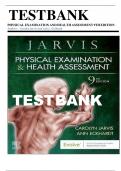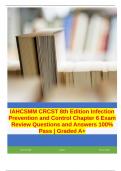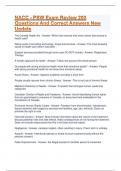TEST BANK v
PHYSICAL EXAMINATION AND HEALTH ASSESSMENT 9TH EDITION
v v v v v v
Authors: Carolyn Jarvis And Ann L. Eckhardt
v v v v v v
TEST BANK v
,TABLE OF CONTENT
v v
Chapter 01: Evidence-Based Assessment .................................................................................................... 3
v v v
Chapter 02: Cultural Assessment ............................................................................................................... 12
v v v
Chapter 03: The Interview ......................................................................................................................... 23
v v v
Chapter 04: The Complete Health History ................................................................................................ 39
v v v v v
Chapter 05: Mental Status Assessment ...................................................................................................... 51
v v v v
Chapter 06: Substance Use Assessment..................................................................................................... 66
v v v v
Chapter 07: Family Violence and Human Trafficking .............................................................................. 72
v v v v v v
Chapter 08: Assessment Techniques and Safety in the Clinical Setting ................................................... 78
v v v v v v v v v
Chapter 09: General Survey and Measurement ......................................................................................... 93
v v v v v
Chapter 10: Vital Signs .............................................................................................................................. 98
v v v
Chapter 11: Pain Assessment ................................................................................................................... 112
v v v
Chapter 12: Nutrition Assessment ........................................................................................................... 119
v v v
Chapter 13: Skin, Hair, and Nails ............................................................................................................ 131
v v v v v
Chapter 14: Head, Face, and Neck, and Regional Lymphatics ............................................................... 149
v v v v v v v v
Chapter 15: Eyes ...................................................................................................................................... 163
v v
Chapter 16: Ears ....................................................................................................................................... 177
v v
Chapter 17: Nose, Mouth, and Throat...................................................................................................... 192
v v v v v
Chapter 18: Breasts, Axillae, and Regional Lymphatics ......................................................................... 207
v v v v v v
Chapter 19: Thorax and Lungs ................................................................................................................ 223
v v v v
Chapter 20: Heart and Neck Vessels........................................................................................................ 239
v v v v v
Chapter 21: Peripheral Vascular System and Lymphatic System............................................................ 254
v v v v v v v
Chapter 22: Abdomen .............................................................................................................................. 268
v v
Chapter 23: Musculoskeletal System ....................................................................................................... 280
v v v
Chapter 24: Neurologic System ............................................................................................................... 297
v v v
Chapter 25: Male Genitourinary System ................................................................................................. 318
v v v v
Chapter 26: Anus, Rectum, and Prostate ................................................................................................. 332
v v v v v
Chapter 27: Female Genitourinary System .............................................................................................. 343
v v v v
Chapter 28: The Complete Health Assessment: Adult ............................................................................ 361
v v v v v v
Chapter 29: The Complete Physical Assessment: Infant, Young Child, and Adolescent ....................... 366
v v v v v v v v v v
Chapter 30: Bedside Assessment and Electronic Documentation ........................................................... 368
v v v v v v
Chapter 31: Pregnancy ............................................................................................................................. 373
v v
Chapter 32: Functional Assessment of the Older Adult .......................................................................... 384
v v v v v v v
,Chapter 01: Evidence-Based Assessment
v v v
Jarvis: Physical Examination and Health Assessment, 9th Edition
v v v v v v v
MULTIPLE CHOICE v
1. After completing an initial assessment of a patient, the nurse has charted that his respirations
v v v v v v v v v v v v v v
are eupneic and his pulse is 58 beats per minute. What type of assessment data is this?
v v v v v v v v v v v v v v v v v
a. Objective
b. Reflective
c. Subjective
d. Introspective
ANS: A v
Objective data is what the health professional observes by inspecting, percussing, palpating,
v v v v v v v v v v v
and auscultating during the physical examination. Subjective data is what the person says
v v v v v v v v v v v v v
about him or herself during history taking. The terms reflective and introspective are not
v v v v v v v v v v v v v v
usedto describe data.
v v v v
DIF: Cognitive Level: Understanding (Comprehension) v v v
MSC: Client Needs: Safe and Effective Care Environment: Management of Care
v v v v v v v v v v
2. A patient tells the nurse that he is very nervous, nauseous, and “feels hot.” What type of
v v v v v v v v v v v v v v v v
assessment data is this?
v v v v
a. Objective
b. Reflective
c. Subjective
d. Introspective
ANS: C v
Subjective data is what the person says about him or herself during history taking. Objective
v v v v v v v v v v v v v v
data is what the health professional observes by inspecting, percussing, palpating, and
v v v v v v v v v v v v
auscultating during the physical examination. The terms reflective and introspective are not
v v v v v v v v v v v v
used to describe data.
v v v v
DIF: Cognitive Level: Understanding (Comprehension) v v v
MSC: Client Needs: Safe and Effective Care Environment: Management of Care
v v v v v v v v v v
3. What do the patient’s record, laboratory studies, objective data, and subjective data combine
v v v v v v v v v v v v
to form?
v v
a. Database
b. Admitting data v
c. Financial statement v
d. Discharge summary v
ANS: A v
The objective and subjective data together with the patient’s record and laboratory studies,
v v v v v v v v v v v v
form the database. The other items are not part of the patient’s record, laboratory studies,
v v v v v v v v v v v v v v v
ordata.
v v
DIF: Cognitive Level: Remembering (Knowledge) v v v
MSC: Client Needs: Safe and Effective Care Environment: Management of Care
v v v v v v v v v v
, 4. When listening to a patient’s breath sounds, the nurse is unsure of a sound that isheard.
v v v v v v v v v v v v v v v
Which action would the nurse take next?
v v v v v v v
a.Notify the patient’s physician. v v v
b.Document the sound exactly as it was heard. v v v v v v v
c.Validate the data by asking another nurse to listen to the breath sounds.
v v v v v v v v v v v v
d.Assess again in 20 minutes to note whether the sound is still present.
v v v v v v v v v v v v
ANS: C v
When unsure of a sound heard while listening to a patient’s breath sounds, the nurse validates
v v v v v v v v v v v v v v v
the data to ensure accuracy by either repeating the assessment themselves or asking another
v v v v v v v v v v v v v v
vnurse to assess the breath sounds. If the nurse has less experience analyzing breath sounds,
v v v v v v v v v v v v v v
vthen he or she should ask an expert to listen. When unsure of a sound heard while listening
v v v v v v v v v v v v v v v v v
vtoa patient’s breath sounds, the nurse should validate the data before documenting to ensure
v v v v v v v v v v v v v v
vaccuracy and before notifying the patient’s physician. To validate that data, the nurse either
v v v v v v v v v v v v v
vrepeats the assessment himself or herself or asks another nurse to assess the breath sounds.
v v v v v v v v v v v v v v
DIF: Cognitive Level: Applying (Application) v v v
MSC: Client Needs: Safe and Effective Care Environment: Management of Care
v v v v v v v v v v
5. The nurse is conducting a class for new graduate nurses. While teaching the class, what would
v v v v v v v v v v v v v v v
the nurse keep in mind regarding what novice nurses, without a background of skills and
v v v v v v v v v v v v v v v
vexperience from which to draw upon, are more likely to base their decisions on?
v v v v v v v v v v v v v
a. Intuition
b. A set of rules v v v
c. Articles in journals v v
d. Advice from supervisors v v
ANS: B v
Novice nurses operate from a set of defined, structured rules to make decisions. It takes time,
v v v v v v v v v v v v v v v
perhaps a few years, in similar clinical situations to achieve competency and it is functioning
v v v v v v v v v v v v v v v
at the level of an expert practitioner when intuition is included in making clinical decisions.
v v v v v v v v v v v v v v v
While information in journal articles and advice from supervisors may assist in making
v v v v v v v v v v v v v
decisions, novice nurses do not typically base their decisions on them. It would also be
v v v v v v v v v v v v v v v
important that if information from journal articles and advice from supervisors were used,
v v v v v v v v v v v v v
thatthey were evidence based.
v v v v v
DIF: Cognitive Level: Understanding (Comprehension) v v v MSC: Client Needs: General v v v
6. The nurse is reviewing information about evidence-based practice (EBP). Which statement
v v v v v v v v v v
best reflects EBP?
v v v
a. EBP relies on tradition for support of best practices.
v v v v v v v v
b. EBP is simply the use of best practice techniques for the treatment of patients.
v v v v v v v v v v v v v
c. EBP emphasizes the use of best evidence with the clinician’s experience.
v v v v v v v v v v
d. EBP does not consider the patient’s own preferences as important.
v v v v v v v v v
ANS: C v






